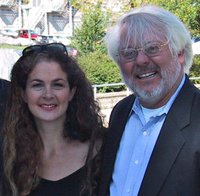
Quick Link
for your convenience!
Human
Rights, Youth Voices etc.
For
Information Concerning the Crisis in Darfur
Whistleblowers
Need Protection

|
| |
“Water Management Ought to be
Central in Development Planning”
Remarks by Hon. David Kilgour, M.P.
Edmonton-Mill Woods-Beaumont
World Water Day Media Conference
Canada and the World Pavilion
Ottawa
22 March 2005
Leonardo da
Vinci once said, “With time, and water, everything changes.” His observation
eloquently captures the biological and spiritual essentiality of water, as well
as its role as a catalyst to progress. It holds particularly true in the context
of community development. With 80% of all sicknesses and diseases in the world
attributed to unsafe water and inadequate sanitation—we, policy makers, NGOs and
civil society groups, must do more to recognize water as an inherent precursor
to sustainable public health. One of the greatest weaknesses in development
efforts worldwide today is the failure to put water management at the forefront
of development planning, acknowledging it’s interconnectedness with food
production, sanitation, labour division, disease prevention, and industrial
growth.
It’s time to show more support for organizations like WaterCan, which implement
locally-attuned, technologically-appropriate, community operated, sustainable
projects. Sadly, water re-habilitation, irrigation and drilling projects make up
a startlingly small percentage of development efforts around the world. In Chad,
for example, where roughly 27% of the population has access to potable water, a
mere 12% of all internationally-funded development projects focus on providing
access to potable water or clean-water management.
One could argue that the root of this devastating oversight lies in the fact
that water is largely taken for granted. North American society, for example, is
based on an abundance of resources, primarily because we are blessed with
tremendous natural resources. Even in cases where we are without, such as the
Palliser Triangle in Prairie Canada, we have the technology and wealth to divert
and transport it from other areas. Thus, our profusion of water shapes our
cultural perceptions of it.
Furthermore, our consumption patterns clearly reflect our abundance and access;
Canadians, for example, use over 100 times the amount of water that most
Africans use and most of us will never have to experience the reality of having
no clean water. It’s hard for us to even imagine such a harsh reality. Magdalene
Creskey, my research assistant, who spent a year working in Tombwa—a small,
desertous coastal town in southern Angola, was told upon arrival in the village
that it had not rained for nearly two years. This town, with a population of
over 35 000, has two communal water pumps, which means that most people get
their water from pits dug in the sand, filled with green, murky water, and
carrying all varieties of bacteria. This town, which was receiving hundreds of
thousands of dollars of aid in building materials and school supplies did not
have one clean water project—this despite the fact that two out of every ten
children were dying of diarrhea due to bacterial infections from the water.
Certainly, there is a great deal to learn from experiencing and discussing
alternate “resource realities,” such as those in sub-Saharan Africa, in an
effort to show Canadians the overwhelming need for effective water-management
strategies within the development sector.
I hope that on this day, World Water Day, Canadians, and people around the
world, take a moment to think about the one billion people on this earth who do
not have access to the very essence of life. May our policies and development
dollars begin to address this fundamental need.
Thank You.
Merci Beaucoup.
|
